These Pothos Plant Benefits are science-backed and confirmed in various studies! And yes! It’s a low-care houseplant that can grow without sunlight!
Pothos is widely grown indoors, thanks to its low maintenance nature and tolerance to low light conditions. However, there’s more than that! Several amazing Pothos Plant Benefits, attested in recent research and studies, making it one of the most beneficial houseplants.
Common Names: Devil’s ivy, Devil’s vine, Golden pothos, Silvervine, Taro vine, Money plant, Silver pothos, Money Plant
Botanical Name: Epipremnum aureum
Here’s all you need to know about growing pothos
Pothos Plant Benefits
1. Low Maintenance Plant
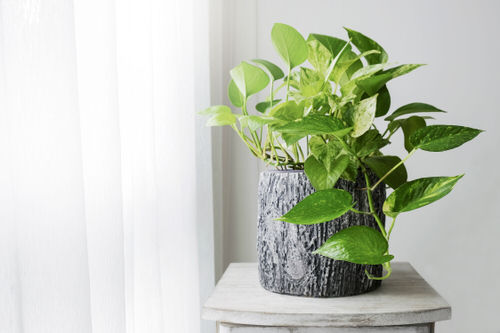
Pothos is a low-maintenance houseplant that does well in various conditions–both sun and shade, moist and dry soil, and a poor substrate.
Although for best results, locate it in bright indirect light and water only when the soil turns dry to the touch. In the case of low lighting conditions, it’ll become less variegated.
Note: According to this study, the golden pothos plant can survive drought.
2. Easy to Propagate
Propagating pothos is one of the easiest things as compared to other houseplants. All you need to do is take a cutting and snip off the lower leaves. Place it in clean water and change the water once a week. That’s it!
Learn everything about propagating pothos here
3. Grows without Sunlight!

Pothos can grow without direct sunlight. It’s a forgiving houseplant that thrives even in low lighting and drought-like condition in cool temperatures. These plants will show less variegation and slow growth but won’t die.
Note: No sunlight doesn’t mean that the plant will survive in a completely dark room. You will have to provide bright, indirect light to it.
4. Purifies Indoor Air
Pothos is very apt at removing VOCs and toxins from the surrounding air. According to the clean air study by NASA, the plant eliminates pollutants such as benzene, toluene, formaldehyde, carbon monoxide, and xylene from the air.
The harmful effect of these pollutants can’t be underestimated, and here’s how these pollutants harm us:
Note: Check out this Japanese study here, which confirms the air purifying capability of the pothos plant.
- Benzene: Frequent exposure to benzene is from tobacco smoke, vehicle exhausts, gas stations, and industrial emissions. Seemingly harmless stuff such as paints, glues, detergents, and furniture wax also raise the benzene levels in the air in indoor space. Exposure to benzene causes damage to the cells in the bone marrow, which can lead to anemia. Long-term exposure to benzene weakens our immune system, making us more susceptible to various diseases and ailments. Check out this detailed article to learn more about benzene and its effects on human health.
- Formaldehyde Pressed wood products, carpets, cigarette smoke, and burning of appliances such as wood-burning stoves, kerosene heaters, and gas stoves without vents are the reason for formaldehyde exposure. Watery eyes, burning sensation in the nose, eyes, throat can happen due to short-term exposure. It can also lead to cancer and leukemia, as stated by the National cancer institute. There are many other adverse effects of formaldehyde on human health, which are stated here in detail.
- Carbon Monoxide: In indoor spaces, carbon monoxide levels rise mostly because of gas heaters, wood fires, clogged chimneys, blocked vents, and some electrical appliances. The people who are at high risk are infants, unborn babies, and elders. Also, if you have a chronic disease, respiratory problems, or anemia, CO exposure can affect you more than a healthy person. Vomiting, headache, nausea, and dizziness are linked to the breathing of CO gas. The high CO levels in the surrounding air can even cause unconsciousness and death. Here is an educational article on the adverse effects of CO.
- Xylene: Xylene is present in adhesives, gasoline, nail paint, and varnishes, along with many household and industrial items. It affects the central nervous system when inhaled and can cause vomiting, nausea, dizziness, and headache. As the consistent exposure increases, the effects become more noticeable and lethal. To learn more about the xylene exposure risk, read this educational article.
- Toluene: Evaporation of toluene from materials such as paint thinners, paints, gasoline, and nail polish leads to its increased concentration in the indoor space. Toluene affects the central nervous system and causes headaches, dizziness, or unconsciousness if you are exposed to it for a short period. Long-term exposure to toluene had serious effects, which can lead to cognitive impairment, incoordination, and loss of vision and hearing. Learn more about this toxic agent in this post.
Pothos can remove formaldehyde and other VOCs effectively. Learn more about that here.
5. Increases Humidity
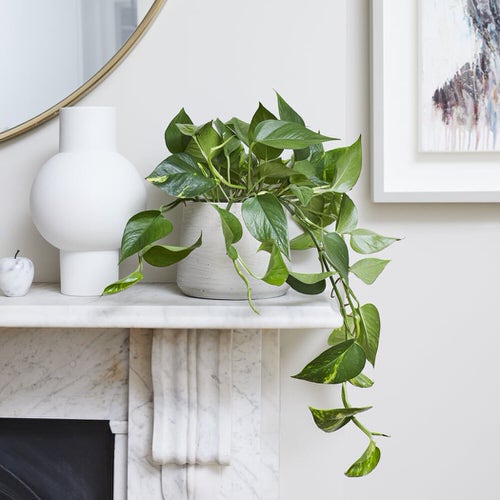
Humid air can protect you from cold and influenza as viruses can’t transmit easily in moist air—it also keeps your skin hydrated. In contrast, dry air multiplies allergic reactions and dust & airborne pollutants. After knowing all these advantages of humid air, it’s good to know that the pothos plant also increases humidity around it.
However, there’s no proper research to guide how many of these plants you need per room for this purpose, but the same NASA experiment also found out that golden pothos is one of the plants that increases humidity.
6. Looks Great!
This one is obvious! Pothos is a trailing plant that can be trained to grow on almost anything. The special feature of this houseplant is that you can have it as a trailing or climbing houseplant, whatever suits you. Plus, unlike other houseplants, it doesn’t become dull under a lack of sunlight.
The variegated bright yellow and green leaves are heart-shaped and look attractive because of their waxy surface. We also added it to our list of heart-shaped indoor plants.
7. A Versatile Plant
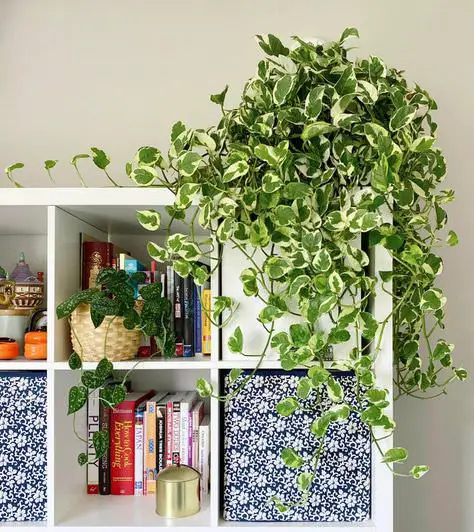
You can train pothos to grow in any desired way, making it a versatile plant for decorative purposes. Place it on a shelf, office desk, table, kitchen countertop, or hang it from the window, stems cascading downwards.
You can also train it in the form of a loop or any other shape.
8. Good Luck Plant
If you believe in Feng Shui, then there are a multitude of golden pothos benefits according to it. Why? Because Feng Shui experts consider it as an energy force that cleanses the negative energy.
It is recommended to keep the pothos near WiFi, television, router, or computer. The potential benefits are reduced stress and improved sleep quality.
Vastu principles believe that this plant brings good luck and positive energy to households. Although planting it in the garden is not recommended by Vastu followers.
9. It’s Hard to Kill!
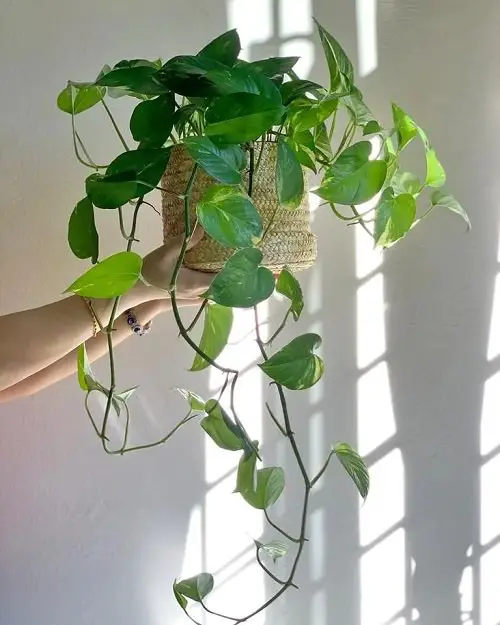
This humble houseplant has many uncommon names. One of them is Devil’s Ivy because it is hard to kill. Moreover, some people consider it a weed.
Also, in many countries, it’s called Money Plant, due to the belief that growing it can make you richer and never let you be short of money.
10. Calming Effect
A study conducted on 14 Japanese men found out that touching the leaves of golden pothos has a calming and peaceful effect on the mind. You can check it out here.
11. Absorbs CO2 & Ozone

One of the best pothos plant health benefits is–it’s an efficient houseplant when it comes to absorbing CO2, according to this Malaysian study.
One research on three common houseplants–Snake plant, spider plant, and pothos, outlines that these plants could also absorb ozone, which is a common indoor air pollutant.
Read this educative article to learn how ozone is harmful to you if it’s present in your home and the sources of its exposure.


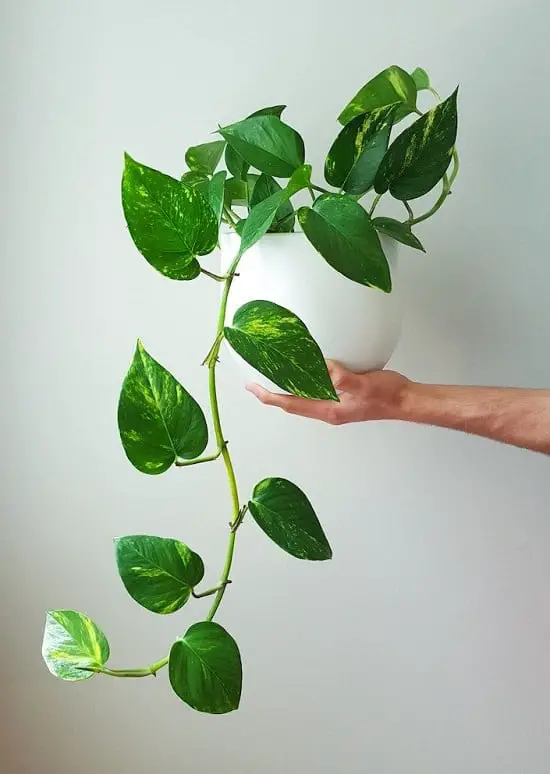

I’ve had one of these plants for 20 years and it’s still alive even though I don’t water it. To be honest I’ve completely forgotten about it.
I have 2 Golden Pothos plants in an aquaponics set-up in my lounge room with a south-eastern aspect (Australia) so only direct sun for a few hours morning and evening during 3 months of summer. They have lost their leaf variegation but are growing madly, being fertilised by the circulating water using a bell siphon, with periodic draining and flooding of about 6 cycles per hour. The garden section is filled with porous clay pebbles and no soil. The aquarium part is about 40 litres capacity, with 10 litres being pumped up into the garden in the cycle, with its total volume also being about 40 litres. At present there are 4 small Striped Danios fish and 1 large golden catfish about 4cm long providing the manure, being fed twice a day. I intend getting 3 or 4 more Danios to increase the fertiliser input. To augment the light I have a series of 3 strips of red and blue LEDs over the plants and 40 watts of fluorescent light in the general area.
My Money plant has been with me for 12 years now. It has survived being left alone during vacation severally! But with just some little care, it thrives…
so it acutally brings luck with money right
Denise, definitely. I found $50 on my doorstep a few minutes after I hung it in my house.
very funny
This plant can be found in mountainous area it can propagate easily
I have one that its in my living room it has two years and its growing so fast she is in the ceiling its such a beautiful all people like
Agree…
Acts 2:38 Acts 22:16 Mark 16:16 fyi gospel